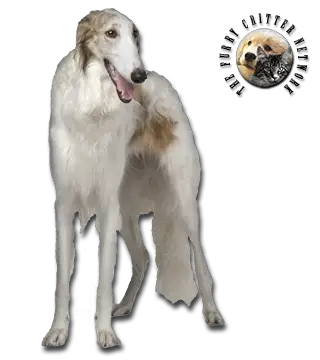Breed Standard
Head: Long, narrow, cleanly cut, finely chiseled. Flat, very narrow skull. Stop practically absent. Slightly curved nosebridge. Large, long, narrow, cleanly cut muzzle. Tight-lipped. Black nose.
Ears: Long, narrow, cleanly cut, finely chiseled. Flat, very narrow skull. Stop practically absent. Slightly curved nosebridge. Large, long, narrow, cleanly cut muzzle. Tight-lipped. Black nose.
Eyes: Large, almond-shaped, dark brown. Opening of the eyelids is edged in black and slightly slanted.
Body: Elongated. Neck long, well-muscled, flattened sideways, without dewlap. Brisket not very pronounced. Long, deep, narrow, flat chest. Pronounced tuck-up. Very muscular back forming an arch especially in males; highest point is at the last rib. Long, broad, muscular croup.
Tail: Set on low, long, forming a sickle. Abundant hair. Carried low at rest. Carried raised but not above the topline in action.
Hair: Long, silky, wavy, but not in large curls. Very thick around the neck, on the lower chest, backs of the legs, and tail. Short on the head, ears, and fronts of the legs.
Coat: White, any shade of gold; silvery gold; gold-shaded; black-shaded tan with dark muzzle and legs; grey; gold, tan, or grey brindle with long stripes of a darker shade; tan; black. Tan markings are allowed but not desirable. Dark-coated specimens have a characteristic black mask. All colors solid or spotted on a white ground.
Size: Dog: 70 to 82 cm. (27.5-32.5 in).Bitch: 65 to 77 cm. (25.5-30.5 in).
Weight: 35 to 45 kg (77.5-99.5 lb).
History
The Borzoi might be the product of crossing the Asian Greyhound with the northern Laika, or the Saluki with a Russian sheepdog, or the Arabian Greyhound with a longhaired indigenous dog. The breed is believed to have been set in Russia in the sixteenth century. The Borzoi was long the favorite pet of large Russian families who used the dog in wolf hunting. Borzois were sent to England in 1842 as gifts to Princess Alexandra. The breed was introduced to western Europe around 1850 and to the United States in 1889. The Russian Revolution of 1917 put an end to breeding by the Russian aristocrats. European breeders worked to protect the Borzoi, and breeding was later renewed in Russia.
Behavior
The very noble, seemingly impassive Borzoi was an excellent hunter of hare, fox, and wolf. Powerful, enthusiastic, and bold, this blue-blood has great stamina and is often attached exclusively to his owner. Not very patient with children, he is indifferent and even hostile toward strangers. He makes a good watchdog but rarely barks. He may bite other dogs. He needs firm but gentle training since he cannot tolerate harsh treatment.
It is better not to keep him in an apartment or leave him alone for long periods. He needs a great deal of space and exercise. He must be kept on a leash on walks, because he may try to chase cats and other animals. He requires brushing two or three times a week.
Function
Hunting dog, watchdog, companion dog.
Health
Prone to bloat. Large meals should be avoided, but rather should have small meals two or three times a day. Avoid exercise after meals. Sensitive to drugs.






